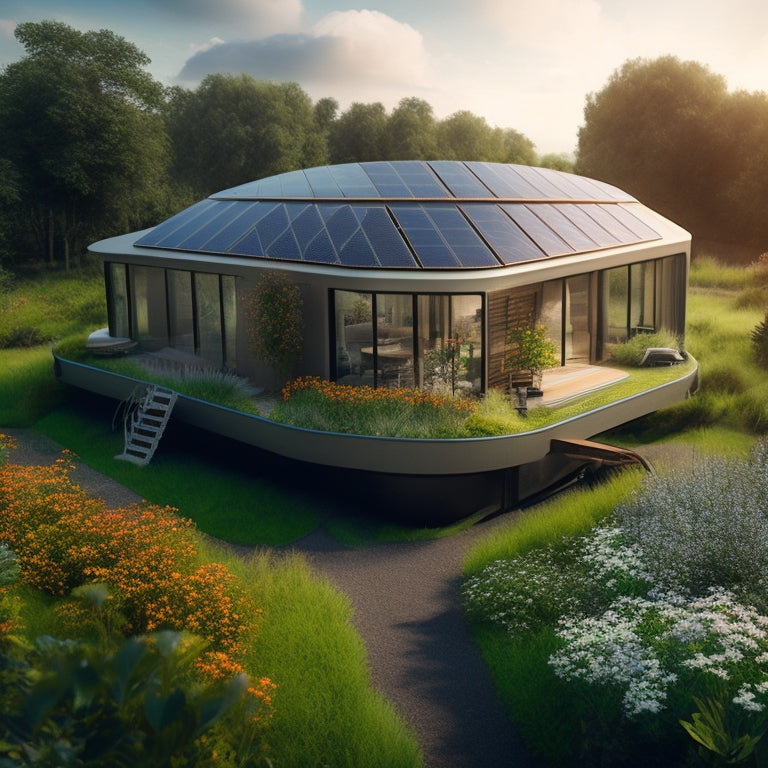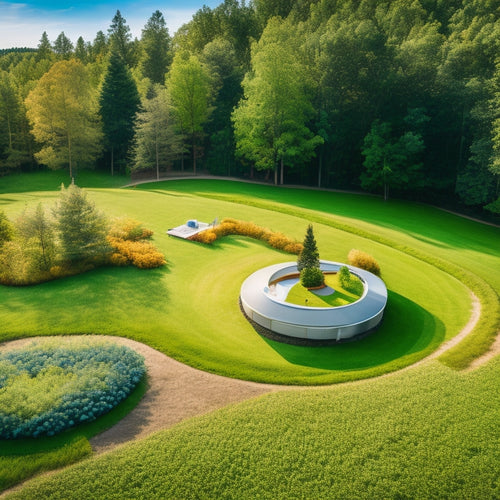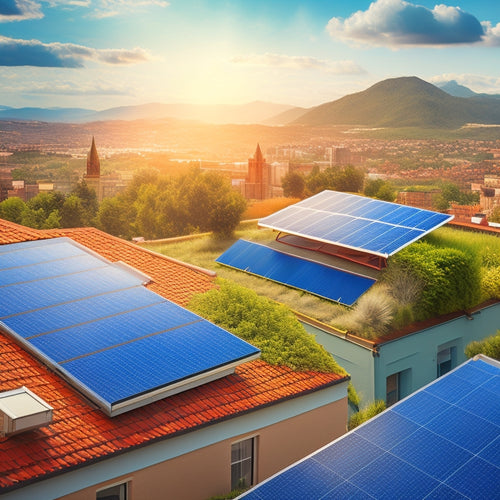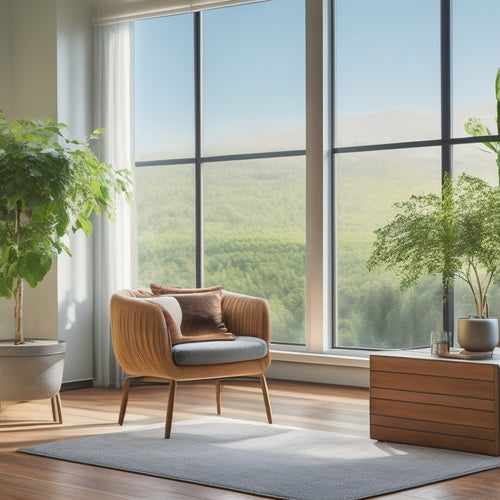
What Recycled Materials Make the Best Eco-Houses?
Share
You're looking to build an eco-friendly home that not only reduces waste but also provides sustainable, durable, and energy-efficient solutions. Consider recycled plastic building blocks for durability and waste reduction, repurposed shipping containers for unique living spaces, and sustainable wood alternatives like bamboo for its strength and renewability. Don't forget recycled glass insulation for high energy efficiency and reclaimed metal roofing materials for a long-lasting, stylish finish. As you investigate these eco-friendly options, you'll find a wealth of innovative materials and techniques that will help you create a truly sustainable home – and there's much more to reveal as you build towards a greener future.
Key Takeaways
- Recycled plastic building blocks provide durability and resistance to harsh weather conditions while reducing environmental impact.
- Repurposed shipping containers offer a unique opportunity to create sustainable living spaces with minimal waste and added green features.
- Sustainable wood alternatives like bamboo, reclaimed wood, and engineered wood products reduce carbon footprint and support eco-friendly construction.
- Recycled glass insulation ensures energy efficiency, sound reduction, and a safe indoor atmosphere while diverting waste from landfills.
- Reclaimed metal roofing materials provide durability, weather resistance, and a stylish aesthetic while reducing waste and conserving natural resources.
Recycled Plastic Building Blocks
Since the dawn of modern design, builders have sought innovative ways to reduce waste and construct eco-friendly dwellings. You're likely wondering what materials can help you accomplish this goal.
One revolutionary solution is recycled plastic building blocks. These blocks are made from plastic waste, reducing the environmental impact of traditional building materials. Regular cleaning and maintenance practices, such as those used in fleet maintenance, can also extend the lifespan of these blocks.
You'll appreciate the plastic durability, which guarantees your eco-house can withstand harsh weather conditions. By using recycled plastic blocks, you're not only reducing waste but also conserving natural resources.
This innovative material allows you to create a sustainable, eco-friendly home that aligns with your values of freedom and environmental responsibility.
Repurposed Shipping Containers
What if you could convert discarded shipping containers into a cozy, eco-friendly abode? You can! Repurposed shipping containers offer a unique opportunity to live sustainably while reducing waste.
With container modifications, you can change these steel boxes into a comfortable living space. Consider adding large windows, solar panels, and a green roof to maximize natural light and energy efficiency. By incorporating sustainable charging solutions and renewable energy sources, you can further reduce your carbon footprint.
When it comes to interior design, the possibilities are endless. You can install reclaimed wood flooring, eco-friendly insulation, and low-VOC paints to create a healthy and inviting atmosphere.
Sustainable Wood Alternatives
You're likely aware that traditional wood isn't always the most eco-friendly choice, which is why you're considering sustainable wood alternatives for your eco-house.
You'll want to investigate options like bamboo, which is incredibly resilient and renewable, as well as reclaimed wood that's been salvaged from old buildings or trees.
Additionally, you'll uncover engineered wood products that combine wood fibers and strands to create a stronger, more durable material.
When it comes to sourcing materials, considering high-efficiency solar panels to power your eco-house can also contribute to a more sustainable lifestyle.
Moreover, looking into energy-efficient solutions can help reduce your carbon footprint.
Bamboo for Building
As you step into the world of eco-houses, you'll find bamboo emerging as a revolutionary element in sustainable building materials, offering a plethora of benefits that make it an attractive alternative to traditional wood. Bamboo's durability and aesthetics make it an ideal choice for eco-conscious builders.
| Feature | Bamboo | Traditional Wood |
|---|---|---|
| Durability | 2-3 times stronger | Prone to decay and rot |
| Aesthetics | Unique, natural beauty | Often requires staining or painting |
| Sustainability | Fast-growing, renewable resource | Slow-growing, depleting resource |
| Cost | Often cheaper than traditional wood | Can be expensive, especially exotic varieties |
Bamboo's impressive strength, natural beauty, and eco-friendly profile make it a top choice for building sustainable, eco-conscious homes that exude freedom and flexibility.
Reclaimed Wood Options
Scores of homeowners are turning to reclaimed wood options, a sustainable alternative to traditional lumber that not only reduces waste but also infuses eco-houses with a rich history and unique character.
By opting for reclaimed wood, homeowners can also reduce their carbon footprint, as it eliminates the need for new lumber and supports the use of solar-powered energy in the construction process.
You can choose from a variety of reclaimed wood sources, including:
- Old barns and factories, where wood has been salvaged and refurbished using advanced wood preservation techniques
- Reclaimed wood markets, where you can find a wide range of wood species and styles
- Salvaged wood from natural disasters, such as hurricanes or wildfires
- Deconstructed buildings, where wood is carefully removed and reused
- Abandoned ships, where wood has been reclaimed and repurposed for construction
Engineered Wood Products
Your eco-house's walls are about to get a whole lot greener with engineered wood products, sustainable wood alternatives that are revolutionizing the construction industry.
These innovative materials combine wood fibers, strands, or veneers to create durable and sustainable building solutions. By incorporating renewable energy solutions, such as solar panels, you can further reduce your carbon footprint and reliance on fossil fuels.
Engineered wood products boast impressive durability, resisting warping, shrinking, and cracking, making them ideal for load-bearing walls and flooring. Plus, they're incredibly eco-friendly, reducing waste and conserving natural resources.
By choosing engineered wood, you'll not only reduce your carbon footprint but also enjoy a longer-lasting, low-maintenance home that aligns with your values.
With engineered wood sustainability and durability, you can build a beautiful, eco-conscious abode that's as gentle on the planet as it's on your wallet.
Recycled Glass Insulation
By the time you start building your eco-house, you'll likely have already considered the importance of insulation.
One innovative solution is recycled glass insulation. This eco-friendly material is made from post-consumer glass waste, diverting it from landfills and reducing the need for virgin materials.
Here are some benefits of recycled glass insulation:
- High energy efficiency: reduces heat transfer and keeps your home warm in winter and cool in summer
- Effective sound insulation: minimizes external noise and creates a peaceful living space
- Non-toxic and non-combustible: guarantees a safe and healthy indoor environment
- Durable and long-lasting: withstands settling and compression, maintaining its performance over time
- Environmentally responsible: reduces waste and conserves natural resources
Bamboo for Eco-Friendly Frames
As you're insulating your eco-house with recycled glass, you're likely thinking about the structure that will hold it all together.
Bamboo frames are an excellent choice for eco-friendly building. Not only does bamboo offer exceptional durability, but it's also a highly renewable resource. Bamboo frames can withstand harsh weather conditions and support heavy loads, making them an ideal option for eco-houses.
Furthermore, bamboo's natural aesthetics add a touch of warmth and coziness to your home. Its unique texture and color create a sense of organic beauty, blending seamlessly with the surrounding environment.
With bamboo frames, you'll enjoy the freedom to design your eco-house with a clear conscience, knowing you're supporting sustainable forestry practices and reducing your carbon footprint.
Low-Carbon Cement Options
About 70% of a building's carbon footprint comes from cement production, making it an essential area for eco-friendly innovation.
You're likely wondering what low-carbon cement options are available for your eco-house. The good news is that several alternatives are emerging, offering a reduced carbon footprint without compromising on performance.
Some promising low-carbon cement options include:
- Using carbon capture technology to reduce emissions during production
- Alternative aggregates like recycled glass or volcanic ash to reduce limestone usage
- Supplementary cementitious materials like fly ash or silica fume to reduce clinker content
- Low-carbon cement blends with reduced clinker ratio
- Geopolymers, a type of cement that uses industrial by-products as raw materials
Reclaimed Metal Roofing Materials
You're likely to be impressed by the vast array of reclaimed metal roofing materials available for your eco-house. From corrugated metal to standing-seam panels, these materials offer numerous metal roofing benefits.
They're durable, resistant to weathering, and can last up to 50 years or more. Plus, they're often made from recycled materials, reducing waste and conserving natural resources.
When it comes to installation techniques, you can opt for a DIY approach or hire a professional. Either way, make certain to follow proper installation methods to guarantee a watertight seal and maximize energy efficiency.
With reclaimed metal roofing materials, you'll not only reduce your carbon footprint but also create a unique, sustainable, and stylish eco-house that reflects your values.
Eco-Friendly Paint Finishes
With your eco-house's reclaimed metal roofing materials in place, it's time to focus on the exterior finishes that'll bring your sustainable vision to life.
Now, it's all about the eco-friendly paint finishes that'll not only protect your home but also minimize its environmental footprint.
You'll want to choose paint options that are free from harsh chemicals and toxins.
Consider the following eco-friendly paint finishes:
- Biodegradable paint made from natural ingredients like plant oils and waxes
- Natural pigments derived from earth oxides, clay, and minerals
- Low-VOC (volatile organic compound) paint that reduces indoor air pollution
- Paints with high recycled content, reducing waste and conserving resources
- Finishes with built-in UV protection, reducing the need for frequent repainting
Salvaged Material Sourcing Tips
As you initiate sourcing salvaged materials for your eco-house, scouring local salvage yards, Habitat for Humanity ReStores, and online marketplaces becomes a treasure hunt for hidden gems.
You'll uncover unique pieces that showcase your commitment to sustainability. When searching, prioritize materials with minimal waste potential and consider upcycling techniques to breathe new life into discarded items.
Focus on high-quality, durable materials that can be repurposed with minimal processing. Effective material sourcing requires patience, creativity, and a keen eye for potential.
Frequently Asked Questions
Can I Build an Eco-House With Entirely Recycled Materials?
You can build an eco-house entirely with recycled materials, embracing sustainable design and reducing waste. By repurposing materials, you'll minimize your carbon footprint, creating a habitat that's not only eco-friendly but also a demonstration of your commitment to a greener future.
Are Eco-Houses More Expensive Than Traditional Houses?
You're wondering if eco-houses break the bank, but here's the thing: while the upfront cost might be higher, you'll reap long-term savings through reduced energy consumption, lower maintenance, and a clear conscience, giving you the freedom to thrive in harmony with the planet.
Do Eco-Houses Require Special Maintenance or Upkeep?
You're steering the eco-house expedition like a captain charting unexplored waters, and now you're wondering about maintenance. Fear not, as eco-houses built with sustainable materials require minimal upkeep, thanks to their energy-efficient design, allowing you to sail smoothly into a guilt-free future.
Can I Build an Eco-House Myself, or Do I Need a Contractor?
You can definitely build an eco-house yourself, leveraging sustainable design and DIY techniques to create a unique, environmentally-friendly space that reflects your values, but be prepared to invest time and effort in the process.
Are Eco-Houses More Prone to Pests or Rodent Infestations?
You're worried eco-houses are a pest paradise, but ironically, they're often less prone to infestations! By incorporating pest prevention strategies and natural deterrents, like essential oils and physical barriers, you'll create a haven that's as uninviting to critters as it is welcoming to you.
Related Posts
-

How to Upgrade Your Home With Geothermal Innovations
You're now on the cusp of utilizing the Earth's natural thermal energy to revolutionize your home's heating and cooli...
-

What Roofing Materials Best Protect Our Planet?
As you consider the environmental impact of your building, you're likely to find that the roofing material you choose...
-

7 Smart Air Purification Hacks for Energy-Savvy Homes
You can notably improve your indoor air quality while minimizing energy consumption by implementing strategic air pur...


